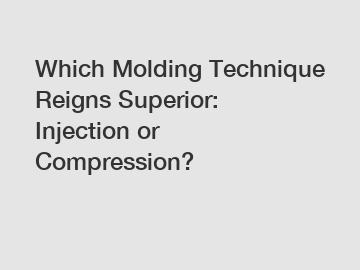Which Molding Technique Reigns Superior: Injection or Compression?
Which Molding Technique Reigns Superior: Injection or Compression?
Throughout the manufacturing industry, molding techniques play a crucial role in the production of various products. Among the many methods available, injection molding and compression molding are two widely-used techniques. Both have their advantages and applications, but which molding technique reigns superior? In this article, we will delve into the differences between injection and compression molding, considering their strengths, limitations, and real-world applications.
1. Injection Molding:

Injection molding is a popular technique that involves injecting molten material, usually plastic, into a mold cavity. It is known for its high production rates, intricate part design capabilities, and consistency in producing complex shapes. This technique utilizes pressure to force the hot material into the mold, ensuring accurate replication of the desired shape.
2. Compression Molding:
On the other hand, compression molding relies on applying heat and pressure to a pre-heated material charge. With this technique, the material is placed directly into the mold cavity, and pressure is then applied, causing the material to spread, fill the mold, and finally cure. Compression molding is commonly used for various materials, including rubber, thermosetting plastics, and composite materials.
Now, let's examine the key points that differentiate these two molding techniques:
- Production Speed and Efficiency:
In terms of production speed, injection molding takes the lead. The fast cycle times associated with injection molding make it suitable for high-volume production runs. The ability to produce large quantities in a relatively short period is a significant advantage for industries where time is of the essence. Conversely, compression molding is a slower process, often resulting in longer cycle times. This method is typically used for lower-volume production or when specific design and material requirements dictate the use of this technique.
- Design Flexibility:
Injection molding offers exceptional design flexibility, making it suitable for intricate part geometries, complex shapes, and fine details. The use of computer-aided design (CAD) software allows for precise control and customization, ensuring precision and accuracy in the final product. Compression molding, although less versatile in terms of design complexity, is well-suited for parts that require consistent thickness, uniformity, and structural integrity. This technique is particularly advantageous for creating flat or simple-shaped parts, such as gaskets or seals.
- Material Choices:
Both injection and compression molding techniques accommodate a wide range of materials. Injection molding primarily focuses on thermoplastics and certain elastomers, offering an extensive selection of materials with varying properties. The ability to use diverse materials provides manufacturers with the flexibility to choose the most suitable material for the specific application. In contrast, compression molding typically revolves around thermosetting polymers, rubber compounds, and composites. These materials offer superior strength, durability, and heat resistance, making them ideal for applications that require these qualities, such as automotive parts or electrical insulators.
- Cost Considerations:
Determining the cost-effectiveness of each molding technique is essential for manufacturing decisions. Injection molding, despite initial setup and tooling costs, becomes more economical for large production runs due to its high-speed cycles. Conversely, compression molding may require less upfront investment but can result in higher per-part costs due to longer cycle times and manual labor requirements.
In conclusion, deciding which molding technique reigns superior ultimately depends on the specific needs of each manufacturing project. Injection molding shines in terms of speed, design flexibility, and material diversity, making it a go-to choice for high-volume production with intricate designs. On the other hand, compression molding becomes advantageous when consistent thickness, structural integrity, and material strength are paramount, particularly for lower-volume runs.
Manufacturers should carefully assess the desired quality, quantity, complexity, and cost considerations before selecting the most suitable molding technique. By understanding the strengths and limitations of injection and compression molding, manufacturers can make informed decisions, maximizing production efficiency and achieving product excellence. So, choose wisely and make the most of the molding technique that aligns with your unique manufacturing requirements.
Are you interested in learning more about dispensing closure, dispensing closure, dispensing closure? Contact us today to secure an expert consultation!


